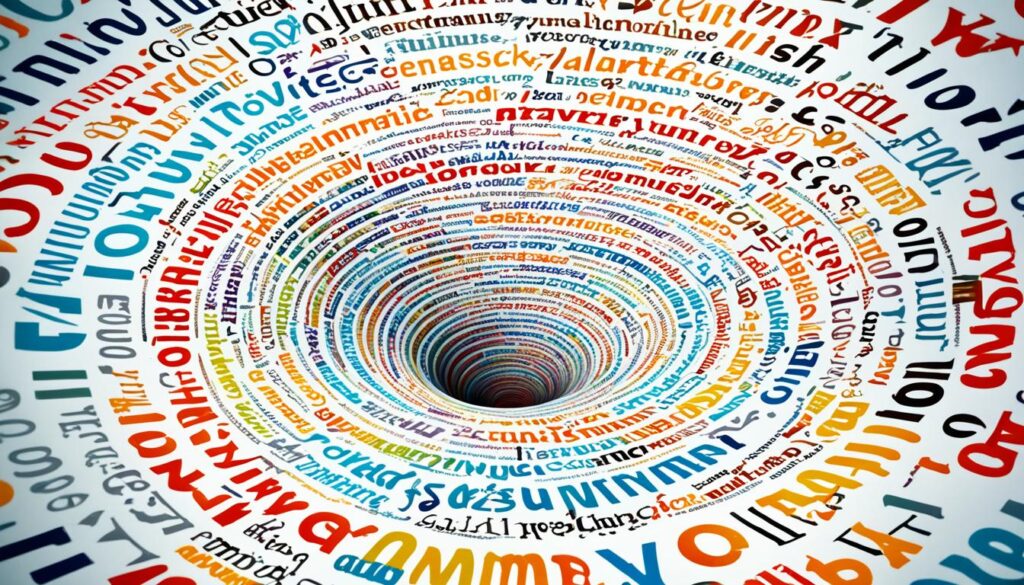Linguistic Features and Figurative Language
Exploring Alliteration and Assonance in Poetry
Delve into the beauty of language with our exploration of The Power of Alliteration and Assonance in World Poetry – a sonic feast for readers.

Ever heard about **alliteration** and **assonance**? These are awesome tools poets use to make their words sound musical and beautiful. While many new poets jump to rhyme, these tricks give poems a cool sound pattern. Alliteration repeats consonant sounds, and assonance repeats vowel sounds. They can grab attention, link ideas, and make poems stick in your mind. Want to learn more? Let’s jump into the magical world of alliteration and assonance in poetry!
Key Takeaways:
- Alliteration and assonance enhance the beauty and musicality of poetry by creating rhythm and directing attention.
- Alliteration involves the repetition of consonant sounds, while assonance focuses on the repetition of vowel sounds.
- These techniques are widely used in world poetry to add depth and musicality to the written word.
- Alliteration and assonance help create associations between words, conveying deeper meanings and emotions.
- By exploring these techniques, writers can enhance their writing and make it more engaging and memorable.
What is Alliteration?
Alliteration is a captivating literary device that employs the melodious repetition of similar or identical consonant sounds at the beginning of words. This playful technique is often showcased in tongue twisters, adding a touch of whimsy to the language. Contrary to popular belief, alliteration doesn’t confine itself to the repetition of the same letter; it can encompass a variety of consonant sounds. Poets and writers utilize alliteration to deliberately direct attention to specific words, create rhythm, and etch their compositions into the reader’s memory. By strategically manipulating the cultural associations tied to certain sounds, words illuminated by alliteration acquire depth and meaning in the grand tapestry of literary artwork.
Alliteration in Tongue Twisters
“She sells seashells by the seashore.”
The use of alliteration in tongue twisters like the famous phrase above demonstrates its ability to generate a playful or comic effect. The repeated “s” sounds create a delightful rhythmic pattern, challenging the tongue to enunciate the swift succession of similar sounds. Alliteration in tongue twisters adds an element of amusement, providing linguistic entertainment for both children and adults.
Captivating Attention and Creating Rhythm
Alliteration serves as an effective tool for capturing attention within a poem or piece of writing. By repeating consonant sounds, writers can make certain words stand out, almost like twinkling stars in a vast night sky. This deliberate emphasis enhances the overall rhythm of the work, creating a melodious flow that resonates with the reader. From classic literature to contemporary compositions, alliteration harmonizes language, enriching the reading experience.
An Example from the Canon
“Do not go gentle into that good night”
Dylan Thomas’s iconic poem “Do not go gentle into that good night” showcases the power of alliteration in poetry. The repetition of the “g” sound in “go gentle” heightens the emotional intensity of the line and directs the reader’s attention to the imperative message within the poem. Alliteration enhances the impact of certain words, allowing them to reverberate in the reader’s mind long after the words themselves have been read.
The Intricacies of Alliteration
Alliteration crafts a symphony of sounds, evoking emotions and creating a symbiotic harmony between words. Its resonance can evoke a range of feelings, from light-hearted, whimsical joy to poignant and powerful intensity. Skilled poets and writers play with the distinctive sounds of consonants to create auditory landscapes that enhance the reader’s connection to the piece. By embracing alliteration, writers can elevate their storytelling, crafting works that linger in the hearts and minds of their audience.
What is Assonance?
Assonance is a poetic technique that involves the repetition of vowel sounds within words. It is a powerful tool that can create a subtle and musical effect in poetry, enhancing the overall experience for the reader. Vowel sounds can be categorized into high and low sounds, each evoking different emotions and tones. High vowels, such as in the word “elegance,” are often associated with sophistication and grace, while low vowels, like those in the word “common,” can evoke a sense of familiarity or coarseness. By repeating these vowel sounds strategically, poets can establish the tone of a poem and create a specific atmosphere.
Similar to alliteration, assonance helps to direct attention and highlight certain words in a poem. Through the repetition of vowel sounds, specific words become more prominent, allowing them to stand out and convey their intended meaning with greater impact. Assonance, along with alliteration and other literary devices, adds depth and complexity to the written word, elevating the overall quality of the poem.
Using assonance in poetry requires a keen understanding of language and sound. Poets carefully select and arrange words to create a harmonious flow, considering the unique qualities of different vowel sounds. By experimenting with assonance, poets can manipulate the emotions and responses of readers, engaging them in a deeper connection with the poem.

Directing Attention and Creating Associations
One of the primary uses of alliteration and assonance in poetry is to direct attention to specific words. By repeating certain sounds, poets can make these words stand out and create a memorable impact on the reader. These techniques can also lead readers to make associations between words, helping to convey deeper meanings and emotions.
In traditional heroic poetry, alliteration is often used to associate positive words with the hero’s initial and negative words with the villain’s initial. For example, in Beowulf, the hero’s name starts with a “B,” and many positive words in the poem also begin with this letter. This association creates a sense of power and strength, emphasizing the heroic nature of the character. On the other hand, negative words and the name of the villain, Grendel, begin with different letters, creating a contrasting effect.
“By repeating the same consonant sounds, the poet directs our attention to particular words and creates associations in our minds. These associations can help shape the overall meaning and emotional impact of the poem.” – Christina Smith
By being aware of the effects of alliteration and assonance, poets can use them purposefully and avoid accidental distractions in their poetry. These techniques allow poets to guide the reader’s attention to important words or ideas, enhancing the overall experience of the poem.
Creating Associations with Alliteration
Alliteration can be used to create associations between words beyond initial sounds. By using words with similar sounds throughout a poem, poets can establish a consistent theme or tone. For example, in T.S. Eliot’s “The Love Song of J. Alfred Prufrock,” the repeated “s” sound in phrases like “streets that follow like a tedious argument” creates a sense of monotony and reinforces the theme of social alienation.
The repetition of consonant sounds can also create subtle connections between words that share similar meanings. For instance, in William Wordsworth’s “I Wandered Lonely as a Cloud,” the repeated “w” sound in phrases like “wandered,” “lonely,” and “cloud” creates a sense of solitude and emphasizes the feeling of isolation in the poem.
Conveying Emotions with Assonance
Similarly, assonance can be used to create associations and convey emotions in poetry. The repetition of vowel sounds can evoke different feelings and moods, adding depth and musicality to the poem. For example, the repeated “o” sound in Edgar Allan Poe’s “Annabel Lee” creates a melancholic and sorrowful tone that resonates throughout the poem.
Assonance can also be used to establish the tone of a poem and create a specific atmosphere. By repeating specific vowel sounds, poets can evoke different sensations in the reader. For instance, the repetition of high vowels like “ee” and “i” in Maya Angelou’s “Phenomenal Woman” creates a sense of elegance and empowerment, highlighting the strength and beauty of the poem’s subject.
| Poem | Alliteration | Assonance | Poetic Effect |
|---|---|---|---|
| Beowulf | Heroic words starting with the letter “B” | N/A | Associates positive qualities with the hero |
| “The Love Song of J. Alfred Prufrock” | Repeated “s” sound | N/A | Creates a sense of monotony and social alienation |
| “I Wandered Lonely as a Cloud” | N/A | Repetition of the “o” sound | Evokes a sense of solitude and isolation |

Creating Rhythm and Musicality
Alliteration and assonance are essential elements in the creation of rhythm and musicality in poetry. These techniques, often used in place of rhyme, establish a rhythmic pattern that gives poetry its unique cadence and flow. By repeating sounds and emphasizing particular words, alliteration and assonance direct the reader’s attention and contribute to the overall musicality of the poem.
The repetition of sounds in alliteration and assonance affects the natural stress of words, influencing the way they are pronounced and creating a sense of rhythm. This rhythmic quality adds to the melodic nature of the poem, enhancing its lyrical appeal. Just as a song relies on a consistent beat to engage its listeners, poetry utilizes alliteration and assonance to establish a comparable rhythmic framework.
“Quoth the Raven, ‘Nevermore.’” – Edgar Allan Poe, “The Raven”
Take, for example, Edgar Allan Poe’s iconic poem “The Raven.” Poe masterfully weaves alliteration and assonance throughout the poem, resulting in its memorable and haunting rhythm. The repeated “r” and “n” sounds in the line “Quoth the Raven, ‘Nevermore’” create a musicality that lingers in the reader’s mind long after the poem has been read.
Adjusting Rhythm and Creating Effects
Writers can harness the power of alliteration and assonance to intentionally adjust the rhythm of their own poetry. By carefully selecting words that contain similar sounds or emphasizing certain syllables through repetition, poets can create specific effects within their work.
For instance, alliteration can be used to quicken the pace of a poem, creating a sense of urgency or excitement. Conversely, assonance can be employed to slow down the rhythm, evoking a contemplative or serene mood. The strategic placement of these techniques allows poets to manipulate the tempo of their work for varying emotional effects.
By considering the importance of alliteration and assonance in creating rhythm and musicality, writers can elevate their poetry to new heights. These techniques add a layer of artistry and engagement, capturing the reader’s attention and evoking vivid imagery through their rhythmic interplay.
The image above visually represents the concept of creating rhythm and musicality through the use of alliteration and assonance in poetry. The intertwining lines symbolize the repetition of sounds that establish the poem’s cadence and the harmonious flow of words.
The Importance of Language in Poetry
The study of poetry terms, such as alliteration and assonance, reminds writers to pay attention to their language, word choice, and sentence structure.
Often, writers focus solely on content and neglect the musicality and richness of language. By learning about these literary devices, writers can enhance their writing by using deliberate repetitions, selecting words that create specific sounds, and crafting sentences that flow smoothly.
Alliteration and assonance offer poets the opportunity to add depth and beauty to their work. By strategically employing these techniques, writers can create a musical quality and evoke a unique emotional response in their readers.
Deliberate Repetitions
One of the key aspects of using alliteration and assonance is the deliberate repetition of specific sounds. These repetitions can create a rhythmic pattern and draw attention to important words or ideas in the poem. By repeating certain consonant or vowel sounds, poets can establish a consistent and harmonious tone throughout their work.
For example, in T.S. Eliot’s poem “The Waste Land,” he employs alliteration to evoke a sense of chaos and uncertainty:
“The river’s tent is broken: the last fingers of leaf Clutch and sink into the wet bank.”
In this excerpt, the repetition of the “s” sound in “river’s,” “tent,” “fingers,” “sink,” and “wet” creates a flowing and immersive experience for the reader. The deliberate use of alliteration helps to establish the tone and atmosphere of the poem.
Word Choice and Sound
When it comes to alliteration and assonance, word choice plays a crucial role in creating the desired effect. Poets carefully select words that not only convey meaning but also produce specific sounds when read aloud. By considering the sound qualities of words, poets can create a more vivid and engaging experience for their audience.
For example, consider the following line from Robert Frost’s poem “Stopping by Woods on a Snowy Evening”:
“Whose woods these are I think I know.”
In this line, Frost uses assonance with the repetition of the long “o” sound in “whose,” “know,” and “snow.” This choice of words enhances the description of a peaceful, serene winter scene. The specific sound reinforces the imagery of the poem and complements the overall theme.
Sentence Flow and Musicality
Alliteration and assonance not only affect individual words but also impact the overall flow and musicality of a poem. By incorporating these techniques, poets can create a rhythm that guides the reader through the lines and stanzas, making the poem feel more cohesive and engaging.
Consider this excerpt from Maya Angelou’s poem “Still I Rise”:
“You may shoot me with your words, You may cut me with your eyes, You may kill me with your hatefulness.”
The repetition of the “you” sound in the first line and the internal rhyme in the second and third lines contribute to the poem’s rhythmic flow. This deliberate use of alliteration and assonance enhances the overall musicality of the poem, making it more powerful and memorable.
Applying Alliteration and Assonance
The use of alliteration and assonance extends beyond poetry. These techniques can be applied to any form of writing to make it more engaging and memorable. By paying attention to language, word choice, and sentence structure, writers can create a more captivating reading experience for their audience.
Both fiction and non-fiction writers can benefit from the deliberate repetition of sounds and the careful selection of words. By incorporating alliteration and assonance, writers can create a sense of rhythm, evoke emotions, and enhance the overall impact of their writing.
- Choose specific consonant or vowel sounds to repeat in your writing, focusing on creating a harmonious and rhythmic flow.
- Select words that not only convey meaning but also produce desired sounds when read aloud. Consider the overall sound qualities of the words and how they contribute to the tone and atmosphere of your writing.
- Craft sentences that flow smoothly and create a musicality in the text. Consider the placement of sounds and how they interact with each other to enhance the overall reading experience.
By consciously incorporating alliteration and assonance into your writing, you can elevate the language, word choice, and sentence structure, making your work more engaging and memorable for your readers.
The Power of Alliteration and Assonance in World Poetry
Alliteration and assonance have a significant impact on the world of poetry. These techniques are widely used by poets from various cultures and time periods to enhance the beauty and musicality of their works. From ancient epics to contemporary free verse, alliteration and assonance can be found in poems across the globe. Writers take advantage of these techniques to create rhythm, direct attention, and convey emotions in their poetry. By exploring the power of alliteration and assonance, readers can appreciate the depth and artistry of world poetry.
When poets employ alliteration, they repeat identical or similar consonant sounds to create a harmonious and melodic effect. This repetition of sounds adds a musical quality to the poem and helps in creating a rhythmic pattern. Alliteration not only enhances the auditory experience but also directs attention towards specific words or phrases, emphasizing their significance within the poem. This technique is utilized extensively in world poetry, showcasing the power of alliteration in evoking emotions and creating memorable verses.
In contrast, assonance employs the repetition of vowel sounds to add a lyrical quality to the poem. The repeated vowel sounds can create a soothing or melancholic atmosphere, depending on the poet’s intention. By carefully selecting specific vowel sounds and arranging them in a pattern, poets can evoke different emotions and enhance the overall musicality of the poem. Assonance, like alliteration, is extensively used in world poetry, highlighting its power in creating aesthetic and evocative verses.
In William Shakespeare’s Sonnet 18, he utilizes assonance to enhance the emotional impact of the poem:
“Shall I compare thee to a summer’s day?
Thou art more lovely and more temperate.”
The use of alliteration and assonance in world poetry exemplifies the power of these techniques in creating captivating and memorable verses. Whether it’s the heroic *epics of ancient Greece*, exploring the beauty of the English language in *Shakespearean sonnets*, or the profound simplicity of *Haiku poetry from Japan*, alliteration and assonance play a vital role in shaping the poetic experience. They offer poets a rich toolkit to create rhythm, convey emotions, and guide the reader through the intricate tapestry of words.
Thus, it is clear that alliteration and assonance are invaluable tools for poets across the globe. These techniques elevate poetry to new heights, allowing readers to immerse themselves in a world of linguistic beauty and artistic expression. By appreciating the power of alliteration and assonance, readers can delve into the diverse world of poetry and witness the mesmerizing impact of these techniques on the written word. So, let the power of alliteration and assonance transport you to the enchanting realm of world poetry.
How to Use Alliteration and Assonance in Your Writing
Incorporating alliteration and assonance into your writing can greatly enhance the musicality and impact of your words. These techniques are not limited to poetry; they can be applied to various forms of writing, such as fiction, journal entries, and blog posts, to add depth and beauty. When revising your work, keep an eye out for opportunities to use alliteration and assonance in order to create rhythm, direct attention, and evoke emotions.
“The beauty of alliteration and assonance lies in their ability to engage the reader’s senses and create a lasting impression.”
Experiment with different sounds and arrangements of words to find the right balance. By playing with language and sound, you can craft sentences that flow smoothly and resonate with your audience. One effective strategy is to read your work aloud, as this can help you identify the intended effect of these techniques and refine your writing further.
Finding the Right Balance
Understanding how to effectively use alliteration and assonance requires finding the right balance in your writing. It’s crucial to avoid overusing these techniques, as excessive repetition can become distracting or monotonous. Consider the tone and purpose of your writing when deciding where and how to incorporate alliteration and assonance. Strategic placement of these techniques can create a powerful impact without overwhelming the reader.
Unleashing Creativity with Alliteration and Assonance
Using alliteration and assonance in your writing not only adds a musical quality but also unlocks your creativity. These techniques allow you to play with language, exploring different sounds and combinations. By consciously selecting words that create specific sounds, you can paint vivid pictures and evoke emotions in your readers.
“Mastering alliteration and assonance offers a doorway to new ideas and fresh perspectives in your writing.”
Engaging and Memorable Writing
When alliteration and assonance are used effectively, they can captivate your readers and make your writing more engaging and memorable. By creating a rhythmic pattern and directing attention to key words, these techniques leave a lasting impact on your audience. As you continue to explore the power of alliteration and assonance, you will discover new ways to make your words sing on the page.
| Benefits of Using Alliteration and Assonance in Your Writing | Examples |
|---|---|
| Enhances the musicality and impact of your words | Her heart hammered with hopeful anticipation |
| Creates rhythm and flow in your writing | The bees buzzed busily in the blooming garden |
| Directs attention to key words or concepts | Her eyes sparkled like stars |
| Elicits emotions and adds depth to your writing | The soothing sound of rain on the rooftop |

Embrace the use of alliteration and assonance in your writing to create engaging, memorable, and impactful pieces. Whether you are a poet or a prose writer, these techniques have the power to elevate your work and leave a lasting impression on your readers.
Conclusion
Alliteration and assonance are powerful tools in the world of poetry. These techniques enhance the rhythm, musicality, and impact of a poem by directing attention, creating associations, and conveying emotions. Poets worldwide have utilized alliteration and assonance in both traditional and experimental forms to create memorable and impactful works. By understanding and incorporating these techniques into your writing, you can explore the power of language and create poetry that resonates with readers.
Embracing the beauty of alliteration and assonance allows your words to sing on the page, capturing the hearts and minds of your audience. The rhythmic repetition of consonant and vowel sounds adds depth and texture to your poetry, creating a symphony of language. Through careful word choice and manipulation, you can create vivid imagery, evoke emotions, and leave a lasting impression.
So, whether you are just beginning your poetic journey or are a seasoned wordsmith, remember the magic of alliteration and assonance. These techniques offer a new dimension to your poetry, transforming ordinary words into captivating melodies. Explore the possibilities, take risks, and let your creativity soar. With the power of alliteration and assonance by your side, your poetry will rise to new heights.
FAQ
What is alliteration?
What is assonance?
What is the purpose of alliteration and assonance in poetry?
How do alliteration and assonance enhance the rhythm and musicality of poetry?
How can alliteration and assonance improve my writing?
How Do Alliteration and Assonance Compare to Onomatopoeia in Poetry?
Alliteration and assonance rely on the repetition of consonant and vowel sounds, while onomatopoeia imitates actual sounds. In poetry, all three sound words across cultures add musicality and vividness to the language, creating a sensory experience for the reader.
Source Links
- https://www.explorewriting.co.uk/alliteration-assonance-poetry.html
- https://www.writingforward.com/writing_exercises/creative-writing-exercises/poetry-writing-exercises-alliteration-assonance
- https://human.libretexts.org/Bookshelves/Literature_and_Literacy/Writing_and_Critical_Thinking_Through_Literature_(Ringo_and_Kashyap)/06:_About_Poetry/6.12:_Sound_in_Poetry-_Alliteration_Consonance_Assonance
Vira, Community Manager – Vira is the dynamic voice behind our community engagement. Vira ensures our readers are heard and engaged, whether addressing inquiries or sparking discussions. Her efforts create a welcoming space for learners and enthusiasts to share insights and deepen their understanding of symbolic languages.
Linguistic Features and Figurative Language
Decoding the Meaning of 'Bought the Farm' Idiom
Unveil the hidden origins and evolution of the 'Bought the Farm' idiom, delving into its historical significance and modern-day usage.

When we decode the 'Bought the Farm' idiom, we uncover its roots in World War II, symbolizing the sacrifice made by fallen soldiers' families. It reflects the stability and American dream associated with owning a farm, offering financial security to those left behind. This phrase acknowledges the ultimate sacrifice of soldiers. Over time, it evolved from a military slang for death to a common euphemism in modern language. Today, it's used humorously in various contexts, adding a touch of playfulness to discussions about mortality. Exploring its progression reveals a rich history and cultural significance worth understanding further.
Key Takeaways
- Originated in WWII as a military slang term.
- Represents the ultimate sacrifice, often in accidents or military settings.
- Symbolizes financial compensation for the families of fallen soldiers.
- Evolved into a euphemism for death in modern language.
- Used in both serious and humorous contexts, adding lightness to discussions about mortality.
Historical Context of 'Bought the Farm' Idiom
During World War II, our military coined the idiom 'bought the farm' to symbolize the sacrifice of fallen soldiers' families who received compensation for mortgages or land purchases. The term 'farm' at that time represented stability and the American dream, as many families aspired to own land. This compensation provided a sense of financial security amidst the devastating loss of their loved ones. The idiom carried a weight of solemnity, acknowledging the ultimate sacrifice made by these soldiers in service to their country.
Receiving compensation to 'buy the farm' was a bittersweet moment for these families, as it meant coming to terms with the permanent absence of their fallen heroes. The phrase encapsulated not only the financial aspect but also the emotional toll of war. The farm, a symbol of prosperity and hard work, became intertwined with the grief and pride of those left behind. Through this idiom, the military sought to honor the memory of the soldiers by ensuring their families were taken care of, even in their absence.
Symbolism Behind 'Bought the Farm' Phrase

What deeper meaning does the phrase 'bought the farm' hold beyond its surface interpretation? To unravel the mystery behind the symbolism of 'bought the farm,' we need to look beyond its literal meaning of death. Originating from the US military during World War II, this idiom carries layers of significance. It symbolizes sacrifice, with families of deceased soldiers receiving compensation that could help pay off mortgages or buy land, hence the association with 'buying the farm.' The term serves as a euphemism for death, softening the harsh reality of loss. Its versatile usage spans serious contexts like military discussions to more light-hearted or informal settings. Below is a table highlighting the symbolic meanings behind the phrase:
| Symbolism | Significance |
|---|---|
| Sacrifice | Represents the ultimate sacrifice made by soldiers |
| Compensation | Provides financial support for families of the fallen |
| Euphemism | Softens the impact of death in conversations |
| Versatility | Used in both serious and humorous contexts |
Evolution of 'Bought the Farm' Meaning

The evolution of the meaning behind 'Bought the Farm' traces back to its origins in US military slang during the 20th century. The phrase 'buy the farm' originally meant to die, often in accidents or military situations. This term likely emerged from US military jargon, with documented references dating back to 1955.
In its early days, the expression was linked to compensating soldiers' families by paying off mortgages or acquiring land. Over time, 'buying the farm' symbolized sacrifice and morphed into a euphemism for death in casual conversations. Today, the idiom is commonly used to soften the stark reality of death and is frequently encountered in action-packed or military-themed contexts.
The evolution of 'buy the farm' showcases how language can transform and adapt, carrying with it the historical weight of its origins while taking on new meanings in modern usage.
Usage of 'Bought the Farm' in Modern Language

Exploring how 'Bought the Farm' is integrated into modern language reveals its humorously macabre undertones in everyday conversations and media portrayals. Let's acknowledge that this idiom has found its way into informal settings to add a touch of lightness to the heavy topic of death.
In movies, books, and casual dialogues, people sometimes use this phrase to refer to someone passing away in a more lighthearted manner. Let's not forget that this usage doesn't diminish the seriousness of death but rather provides a quirky way to talk about it without being overly solemn.
Incorporating 'Bought the Farm' into modern language showcases how language evolves to handle sensitive subjects with a dash of humor. By using this idiom in a casual context, individuals can navigate discussions about mortality with a hint of playfulness, making it a fascinating aspect of contemporary language dynamics.
Comparing 'Bought the Farm' With Similar Idioms

Comparing 'Bought the Farm' with similar idioms sheds light on the creative ways language captures the concept of death with humor and cultural relevance. Idioms can help us understand how different cultures express the idea of death in unique and amusing ways.
For instance, the phrase 'Kick the bucket' and 'Bite the dust' are also idioms that playfully refer to someone's passing. These idioms not only add color to our language but also offer insights into the cultural attitudes towards death. Understanding idioms like 'Bought the Farm' not only enhances our language skills but also deepens our cultural awareness.
Frequently Asked Questions
What Does the Idiom Bought the Farm Mean?
Having knowledge of the fact that 'bought the farm' means to die, often in an accident or military context. This American idiom symbolizes death, originating during World War II to represent sacrifice and the financial compensation for soldiers' families.
It's commonly used informally to soften the reality of death. Understanding idioms like this adds depth to language skills and conversations, enriching our communication abilities.
What Does Buy the Farm Mean in the Military?
We define 'buy the farm' in the military as a colloquial term indicating someone has died, often in an accident or combat scenario. This expression, originating from US military slang, symbolizes sacrifice and euphemistically signifies death.
Families of deceased soldiers may have received compensation, possibly for purchasing land or settling mortgages. Humorously used in action or military settings, the phrase humorously alludes to someone's passing.
What Is the Expression Selling the Farm?
Selling the farm involves a significant and final decision to dispose of one's property or assets. This expression can carry literal or figurative meanings, symbolizing a major change or sacrifice.
In a literal sense, it refers to selling agricultural land. Figuratively, it conveys letting go of something valuable or making a decision with lasting impact. It often signifies giving up something substantial or important in one's life.
What Does It Mean to Farm Someone?
When we talk about farming someone in gaming, it means repeatedly defeating a player or group to gain advantages like experience points or resources efficiently. This can be unsportsmanlike and lead to frustration.
Players might use tactics like camping spawn points or using powerful weapons. Game developers sometimes put in measures to stop or discourage this behavior.
It's a controversial strategy that can impact the gaming experience for everyone involved.
Conclusion
To sum up, deciphering the meaning of the idiom 'bought the farm' reveals its origins in military slang, symbolizing the ultimate sacrifice.
Over time, the phrase has evolved to represent any irreversible loss or demise. Its usage in modern language reflects its enduring significance and resonance.
Like a well-worn path through a familiar field, 'bought the farm' remains a timeless expression conveying the weight of finality and consequence.
Vira, Community Manager – Vira is the dynamic voice behind our community engagement. Vira ensures our readers are heard and engaged, whether addressing inquiries or sparking discussions. Her efforts create a welcoming space for learners and enthusiasts to share insights and deepen their understanding of symbolic languages.
Linguistic Features and Figurative Language
Figurative Language Techniques Help Characterize Monsters: Mastering Descriptions
Kaleidoscope of metaphors and similes bring monsters to life, leaving readers enchanted by the depths of characterization.

Utilizing metaphors, similes, and personification in monster descriptions enhances storytelling by painting vivid pictures and evoking emotions. These figurative language techniques make monstrous qualities relatable and add layers of depth to characters. Crafting detailed imagery through descriptive language appeals to the senses and shapes readers' perceptions of monsters. Comparing monsters to objects or emotions adds depth, while hyperbole exaggerates their intimidating qualities. Mastering these techniques not only makes monsters engaging and relatable but also enriches the overall storytelling experience. Enhancing descriptions with figurative language not only evokes fear, awe, or sympathy towards monsters but also adds intricate layers to their personalities.
Key Takeaways
- Metaphors and similes create vivid imagery for monster descriptions.
- Personification humanizes monsters, making them relatable characters.
- Figurative language evokes emotions like fear, awe, or sympathy towards monsters.
- Descriptive language shapes readers' perceptions and understanding of monsters.
- Symbolism enriches storytelling by adding deeper layers to monster characterization.
Utilizing Metaphors for Monster Descriptions
When crafting descriptions of monsters, we employ metaphors to paint vivid and evocative pictures for our readers. By using metaphors, we can evoke powerful emotions and create a deeper understanding of a monster's nature and behavior. Comparing a monster's characteristics to familiar objects or concepts through metaphors helps in portraying their monstrous qualities in a more relatable manner. This technique not only enhances the storytelling but also adds layers of meaning to the monster's characterization, providing readers with a richer experience.
Metaphors play an important role in illustrating the essence of monsters, allowing us to explore their complexities and intricacies. Through clever comparisons and imaginative language, we can bring out the unique traits and features of these creatures, making them more engaging and compelling to the audience. Essentially, metaphors serve as a bridge between the fantastical world of monsters and the readers, enabling a more profound connection and a more immersive storytelling experience.
Crafting Vivid Imagery to Portray Monsters

To vividly portray monsters, we employ detailed descriptions that evoke fear, empathy, or curiosity in our readers. Crafting vivid imagery is essential in bringing these creatures to life in the minds of the audience. By using descriptive language that appeals to the senses, we can create a strong emotional impact and enhance the overall narrative experience. One effective way to achieve this is through the use of similes and metaphors, allowing for comparisons between monster characteristics and familiar objects or emotions. This technique not only aids in understanding but also adds depth to the portrayal of monsters. Additionally, personification can be employed to give monsters human-like qualities, making them more relatable or unsettling to readers. Through careful selection of words that paint a clear picture of the monsters' size, shape, color, and movement, we can ensure that our audience visualizes these creatures with vivid clarity.
| Techniques | Benefits |
|---|---|
| Similes and Metaphors | Enhance understanding and add depth to portrayal |
| Personification | Makes monsters more relatable or unsettling |
| Descriptive Language | Creates strong emotional impact |
| Comparison | Helps readers visualize monster characteristics |
Personification Techniques in Characterizing Monsters

Employing personification techniques in characterizing monsters allows for the attribution of human traits to non-human entities, enhancing the vividness and complexity of their descriptions. By infusing monsters with human traits such as emotions and behaviors, authors create more engaging and relatable characters.
When a monster's actions mirror human behavior, it becomes easier for readers to connect with the creature on a deeper level, making the characterization more intricate and compelling. Describing a monster's movements as graceful or its gaze as filled with curiosity adds layers to its personality, painting a more vivid picture in the reader's mind.
Personification not only enriches the portrayal of monsters but also provides insight into their inner workings, allowing for a deeper exploration of their motivations and intentions. Through the lens of human traits, monsters transform from mere creatures into complex beings with a range of emotions and behaviors, captivating readers with their depth and unpredictability.
Enhancing Descriptions Through Figurative Language

Using figurative language techniques in monster descriptions enhances the vividness and memorability of these fantastical creatures. By incorporating similes and metaphors, we can compare monsters to various characteristics or objects, allowing readers to visualize them more vividly. For example, describing a monster's scales as shiny as polished armor or its roar like thunder can create a more immersive experience.
Personification is another valuable tool that can be used to give monsters human-like qualities or behaviors, adding layers to their characterization. Hyperbole, through exaggeration, can make monsters even more intimidating or fascinating in the narrative, leaving a lasting impression on the audience. Symbolism in figurative language can also play an important role in monster descriptions, representing deeper meanings or themes related to the creatures, thus enriching the overall storytelling experience.
Through vivid imagery, comparisons, and deeper meanings, figurative language breathes life into monsters, making them unforgettable in the minds of readers.
Mastering Monster Characterization With Figurative Language

Comparing monsters to natural elements or emotions through figurative language adds depth to their characterization, allowing readers to immerse themselves in the vivid world of these fantastical creatures. By utilizing metaphors and similes, we can paint a more intricate picture of these monsters, making them more than just frightening beings on the page.
Personification and imagery play vital roles in crafting detailed and engaging monster characters that resonate with readers. When we employ descriptive language that evokes emotions or connects monsters to familiar elements, we shape how readers perceive these creatures.
Figurative language has the power to evoke fear, awe, or even sympathy towards monsters, influencing the overall storytelling experience. Mastering the art of figurative language in monster descriptions can elevate the narrative, making these creatures more relatable or terrifying in the minds of the audience.
Through skillful use of figurative language, we can enhance monster characterization and create a more immersive and enthralling story for readers to explore.
Frequently Asked Questions
How Can Figurative Language Help Characterize a Monster in a Story?
Figurative language enhances a monster's characterization by painting vivid pictures in readers' minds. Metaphors and similes draw comparisons that highlight unique traits or monstrous features.
Personification humanizes the monster, making it relatable or sympathetic. By skillfully using these techniques, authors create complex and compelling monsters that resonate emotionally.
Figurative language adds depth and intrigue to monster characters, making them more memorable and engaging for readers.
What Are Examples of Figurative Language Techniques?
When crafting descriptions, figures of speech play an essential role. Metaphors compare monsters to our deepest fears, while similes liken them to powerful forces like storms or predators. Personification gives them human traits for added terror. Hyperbole magnifies their monstrosity, highlighting their menace.
Alliteration and onomatopoeia create chilling sounds linked to these creatures, deepening their mystery. Mastering these techniques enhances our ability to vividly portray these formidable beings.
What Are the Types of Figurative Language in Frankenstein?
When it comes to figurative language in 'Frankenstein,' we find a variety of techniques like similes, metaphors, and personification. These literary devices help bring the story to life by comparing unlike things, creating vivid imagery, and adding depth to characters and themes.
Similes use 'like' or 'as' to draw parallels, metaphors directly compare two things, and personification gives life to nature and inanimate objects. Together, they enrich the storytelling experience and deepen our understanding of the narrative.
What Writing Techniques Are Used in Frankenstein?
We employ various writing techniques in Frankenstein to enhance the narrative. Symbolism, for instance, imbues deeper meanings into the storyline. It enriches the themes of ambition, isolation, and societal rejection.
Literary devices like foreshadowing, allusions, and symbols build tension and connect the narrative to broader literary traditions. These techniques not only engage readers but also provide a more profound understanding of the characters and themes in the novel.
Conclusion
To summarize, mastering the use of figurative language techniques is vital in characterizing monsters effectively. Metaphors, vivid imagery, and personification all play a significant role in creating vivid and memorable descriptions.
As the saying goes, 'A picture is worth a thousand words,' using these techniques allows readers to visualize and connect with these monstrous beings on a deeper level.
By honing these skills, writers can bring their monsters to life in a way that captivates and intrigues their audience.
Boaz, Founder and Chief Editor – With a profound linguistics and anthropology background, founded What Does Meanings to explore the intricate connections between language, symbols, and cultural identity. His vision has guided the platform from its inception, ensuring that each piece of content enriches our understanding of the world’s symbolic heritage.
Linguistic Features and Figurative Language
Expert Tips for Using Idioms in Your Formal Writing
Yearning to elevate your formal writing? Dive into expert tips for using idioms that will enhance your message and captivate your audience.

When incorporating idioms into formal writing, we must align them with the intended tone, guarantee clarity, and maintain professionalism. Common idioms like 'hit the nail on the head' work well, while overly colloquial ones should be avoided. Understanding idiomatic meanings is essential for deeper comprehension and adding creativity to our writing. Integrating idioms contextually enhances our message, but we must edit them for clarity and cultural relevance to resonate with our audience. Seeking feedback for idiomatic usage from peers or professionals can further refine our writing. Embracing these expert tips can elevate the impact of idioms in formal communication.
Key Takeaways
- Align idioms with the intended tone and keep them easily understandable.
- Use common idioms like 'hit the nail on the head' for professionalism.
- Ensure idioms enrich writing with creativity and depth.
- Tailor idioms to specific audience and purpose in formal writing.
- Seek feedback on idiom usage for clarity and cultural relevance.
Selecting Appropriate Idioms
When incorporating idioms into formal writing, it's important to carefully select ones that align with the intended tone and are easily comprehensible to the audience. Utilizing formal language is essential in maintaining the professionalism of your writing. Common idioms, such as 'hit the nail on the head' or 'barking up the wrong tree,' can add a touch of familiarity without detracting from the formality of the piece.
It is important to choose idioms that are widely recognized and appropriate for the context in which they're used. Overly colloquial or slang idioms should be avoided in formal writing situations, as they may not resonate well with the intended audience seeking a sense of belonging. By selecting common idioms that are easily understood, you can effectively enhance the message you wish to convey without compromising the formal tone of your writing.
Understanding Idiomatic Meanings

Understanding idiomatic meanings is essential for effective communication as it allows for a deeper comprehension of figurative language. By grasping idiomatic expressions, individuals can convey ideas in more creative and engaging ways.
Exploring idioms like 'barking up the wrong tree' or 'hit the nail on the head' reveals the richness of language beyond literal interpretations.
Idiomatic Expressions Explained
Exploring the depths of idiomatic expressions reveals their nuanced meanings beyond literal interpretation. Idioms can enrich formal writing by adding a layer of creativity and depth. Understanding these expressions enhances communication and keeps readers engaged. Idioms are rooted in culture and may differ across regions, making it essential to choose them wisely based on the audience and context. Below is a table outlining common idiomatic expressions and their meanings:
| Idiomatic Expression | Meaning |
|---|---|
| Break the ice | To initiate a conversation or activity |
| Hit the nail on the head | To describe someone who is exactly right |
| Piece of cake | Something very easy to do |
| Costs an arm and a leg | Very expensive |
| Let the cat out of the bag | To reveal a secret |
Understanding these idioms can add flair to your writing and facilitate better communication.
Interpreting Figurative Language
Delving into figurative language enriches writing by imbuing it with vibrant expressions that transcend literal meanings. When it comes to interpreting idiomatic meanings, it's important to delve beyond surface-level understanding.
Here are some key points to keep in mind:
- Idiomatic meanings go beyond literal interpretation, adding depth and color to language use.
- Understanding idioms is essential for effective communication and cultural awareness.
- Figurative language, like idioms, enhances writing by conveying abstract concepts vividly.
- Idioms help express complex ideas in a concise and engaging manner.
- Interpreting idiomatic meanings requires recognizing the figurative implications of phrases.
Contextual Integration of Idioms

Considering the importance of idioms in formal writing involves tailoring their usage to the specific audience and purpose to maintain professionalism and clarity. When integrating idioms into your writing, it is vital to make sure that they align with the context of your message and enhance rather than detract from its meaning. To help you understand how to seamlessly integrate idioms into formal writing, we have provided a table below that illustrates the contextual integration of idioms.
| Context | Purpose | Appropriate Idiom |
|---|---|---|
| Academic Writing | Emphasizing a point | 'The findings of the study paint a clear picture.' |
| Professional Correspondence | Expressing gratitude | 'I would like to extend my heartfelt thanks for your support.' |
| Business Reports | Highlighting success | 'The new marketing strategy really hit the nail on the head.' |
Maintaining Formality With Idioms

When incorporating idioms in formal writing, it's important to contemplate their appropriateness within the academic context. Some idiomatic expressions can be acceptable in scholarly tasks, especially in fields like literature or social sciences.
Understanding the tone and guidelines for using idioms is essential for maintaining formality in academic writing.
Idioms in Academic Writing
In academic writing, the judicious use of idioms enhances the depth and richness of scholarly discourse, particularly within disciplines like literature, history, and philosophy.
- Incorporating idioms can add a layer of sophistication to your arguments.
- Carefully selecting idioms that align with your topic can illustrate complex ideas concisely.
- The context of your writing and the expectations of your audience determine the appropriateness of idiomatic expressions.
- Editors may have varying opinions on the inclusion of idioms in academic papers.
- Understanding when to use idioms, like 'the early bird catches the worm,' can elevate the clarity and impact of your academic work.
Proper Usage Guidelines
In order to maintain formality in writing while incorporating idioms, writers should carefully evaluate the appropriateness of idiomatic expressions based on the specific context and target audience. While idioms can add color and depth to language, they mightn't always be suitable for formal settings like academic papers or professional correspondence. It's important to assess whether the use of idioms aligns with the tone and purpose of the writing.
In everyday conversations, idioms are more commonly accepted; however, in formal settings, their usage should be judicious. For instance, idioms like 'to alter beyond recognition' may be deemed acceptable in certain formal contexts due to their clarity and sophistication. Understanding these nuances is essential for effective communication in various writing tasks.
Tone and Idioms
Careful consideration of the appropriateness and alignment of idiomatic expressions with the intended tone is essential when aiming to maintain formality in writing. When incorporating idioms into formal writing, remember that tone speaks louder than words. To maintain professionalism, choose idioms that complement rather than detract from the desired formality.
Just like judging a book by its cover, the tone of your writing sets expectations for the reader. Thoughtfully selecting idioms can add sophistication to your formal writing. Context and audience play an important role in determining the suitability of idioms.
Striking a balance between idiomatic expressions and formality is vital for effectively integrating them into your writing.
Using Idioms for Emphasis

Carefully selecting idiomatic expressions can greatly enhance the impact and emphasis of formal writing.
Idioms, like 'the early bird catches the worm,' are commonly used to add depth and intensity to your message.
When used strategically, idioms can captivate your audience, making your writing more engaging and memorable.
The key is to make certain that the idioms you choose align with the overall tone and purpose of your formal writing.
Avoiding Overuse of Idioms

We must strike a balance in incorporating idioms into formal writing to maintain professionalism and clarity. When we overuse idiomatic expressions, we risk diluting the impact of our message and causing confusion among our readers.
To avoid these pitfalls, consider the following tips:
- Select idioms strategically: Choose idioms that add value to your writing without overpowering its essence.
- Avoid clichés: Steer clear of overly used idioms that may come across as trite or unoriginal.
- Consider your audience: Make sure the idioms you use resonate with your readers and enhance their understanding.
- Review for relevance: Double-check that the idioms you include align with the overall message you aim to convey.
- Watch out for overused phrases: Be wary of common expressions like 'cold feet' or 'barking up the wrong tree' that may lose their impact through repetition.
Editing Idioms for Clarity

How can we guarantee that idioms in formal writing are edited for clarity and alignment with the intended tone and message? When editing idioms for clarity, it is crucial to verify they convey the intended meaning without causing confusion. This process involves confirming that the idiomatic expressions used are appropriate for the formal context and contribute positively to the overall message. We must remember that clarity is key in formal writing, and ambiguous idioms can lead the reader down the wrong tree, impacting comprehension.
To assist in editing idioms effectively, consider the following guidelines:
| Means of Editing Idioms | Examples of Clarity Enhancements |
|---|---|
| Replace ambiguous idioms with clearer language | 'Cut to the chase' → 'Get to the main point' |
| Seek feedback from peers or editors on idiom usage | Ask for input on the effectiveness of idioms in conveying the intended message |
| Ensure idiomatic expressions align with the formal tone | 'Spill the beans' might not suit a professional report |
| Check if idioms enhance the intended message | Evaluate if the use of idioms adds value or detracts from the writing |
Checking Idioms for Cultural Relevance

Considering the impact of cultural relevance when evaluating idioms for formal writing is essential to guarantee effective communication with the intended audience. It ensures that the message is understood clearly and that the idioms resonate appropriately with the readers.
Here are some key points to keep in mind when checking idioms for cultural relevance:
- Research the cultural connotations of idioms to avoid misunderstandings.
- Understand the origin and usage of idioms to grasp their cultural significance.
- Adapt idioms to fit the cultural context of your writing for better clarity.
- Avoid using idioms with specific cultural references that may not be universally understood.
Good luck in selecting idioms that are culturally relevant and enhance the impact of your formal writing.
Seeking Feedback on Idiomatic Usage

Seeking feedback on idiomatic usage can greatly enhance the quality of formal writing. Requesting input from peers, teachers, or writing professionals is crucial to improve the effectiveness of idioms in your writing.
Consider joining writing groups or forums where members can provide constructive criticism, helping you refine your idiomatic expressions. Online writing tools or platforms can also offer feedback on the appropriateness of idioms in formal writing contexts, giving you a little bit of extra help in honing your skills.
Seeking guidance from language experts or tutors is another valuable avenue for gaining insights into using idioms effectively. Reviewing samples of formal writing can provide you with examples of how idioms are incorporated and their impact on tone and style.
Frequently Asked Questions
Is It OK to Use Idioms in Formal Writing?
Yes, utilizing idioms in formal writing can be important, but it depends on the context and audience. Some idioms, like 'in spite of' or 'to alter beyond recognition,' are more suitable.
In academic fields such as literature, history, and philosophy, idioms may find a place. However, it's essential to carefully assess the appropriateness.
Awareness of when to use idioms is significant, especially for exams like IELTS.
How Can You Use Idioms in Your Writing?
We can effectively use idioms in writing by selecting universal phrases for clarity. Consider the audience and context for appropriate usage. Using idioms sparingly adds creativity without losing professionalism.
Strategic inclusion of idioms enhances reader engagement and understanding. Remember, clarity and precision are key in formal writing. Choose idioms wisely to maintain a professional tone while adding color to your text.
How Do You Use Idioms Effectively?
When using idioms, we should carefully select ones that match the formal tone required. It's essential to incorporate them strategically, avoiding overwhelming the reader with informal language.
Considering cultural implications is vital to prevent misunderstandings. Seeking feedback from peers or editors can help guarantee the professionalism of our writing.
Can Idioms Be Used in Formal Letters?
Yes, idioms should generally be avoided in formal letters to maintain a professional tone. Clear and direct communication is essential in formal writing, and using idiomatic expressions can detract from the message's clarity.
Opting for formal language and traditional expressions guarantees the professionalism expected in formal letters. Respecting formal communication conventions is key to effectively conveying your message in a formal setting.
Conclusion
To sum up, incorporating idioms into formal writing can add flair and depth to your language. By carefully selecting appropriate idioms, understanding their meanings, integrating them seamlessly into your context, and using them sparingly for emphasis, you can enhance the clarity and impact of your writing.
Remember to edit for clarity, cultural relevance, and seek feedback on your idiomatic usage to guarantee your message is effectively communicated. Embrace the power of idioms in your writing, but do so with caution and precision.
Vira, Community Manager – Vira is the dynamic voice behind our community engagement. Vira ensures our readers are heard and engaged, whether addressing inquiries or sparking discussions. Her efforts create a welcoming space for learners and enthusiasts to share insights and deepen their understanding of symbolic languages.
-

 Cultural and Historical Symbols2 months ago
Cultural and Historical Symbols2 months agoUnderstanding “What Does Eid Mubarak Mean”
-

 Modern Symbols and Signs1 month ago
Modern Symbols and Signs1 month agoSubaru's Dashboard Symbols Unraveled: 10 Meanings
-

 Cultural and Historical Symbols2 months ago
Cultural and Historical Symbols2 months agoExploring Crosses and Their Meanings in Depth
-

 Modern Symbols and Signs1 month ago
Modern Symbols and Signs1 month agoUnderstanding the Meaning of a Question Mark Road Sign
-

 Modern Symbols and Signs2 months ago
Modern Symbols and Signs2 months agoIs Five Guys Closing Permanently? The True Story
-

 Cultural and Historical Symbols4 weeks ago
Cultural and Historical Symbols4 weeks agoThe Cultural Insight of 'Pinche Gringo' Meaning
-

 Cultural and Historical Symbols4 weeks ago
Cultural and Historical Symbols4 weeks agoKing Abdulaziz University Blackboard Guide
-

 Linguistic Features and Figurative Language1 month ago
Linguistic Features and Figurative Language1 month agoWhy Idioms Are Important for Colorful and Rich Language


















